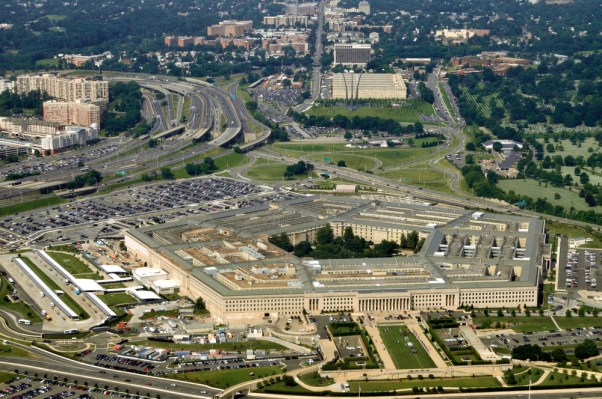The U.S. Secretary of Defense, Ashton Carter, has made two trips to Silicon Valley this year, but has only spoken directly to his counterpart in Russia once in the same period — despite NATO being on its highest possible alert level.
That’s how serious the Pentagon is about courting Silicon Valley to bolster defense innovation.
Just as the Defense Department is scouring the Bay Area for good ideas (and has even set up a sort of consul outpost at Moffett Field), it also is turning a hard eye on itself.
The military’s leaders want to change the culture of the world’s largest bureaucracy and cut red tape in both acquiring technologies and working with new companies. They are hoping that the startups and tech giants of Silicon Valley will form — to use the DC-jargon — a new “defense industrial base,” or “DIB 2.0” supplier base.
Despite this intense focus on how to get Silicon Valley to share its best ideas with the U.S. government, something crucial is being overlooked: The companies of “DIB 2.0” are worried that working with the military will restrict exports of their ideas to the world’s biggest international markets, including China.
American export laws meant to keep weapons away from adversaries (many dating to the Cold War) now ensnare sales of certain high-tech products, of which the U.S. is a leading producer, such as satellites and software, as well as robotics and artificial intelligence. The Pentagon has so far missed how important of a hurdle this is to big and small tech companies, alike. Companies have a duty to investors, shareholders and employees to go big when they think about selling their next algorithm or widget.
Typically, the government’s response is to fall back on the size of the Defense Department’s more than $500 billion annual budget. The reality, however, is global commercial markets are much bigger for many of these key technologies. Take the military’s cyber defense market, which is about $5 billion this year. Weigh that against a nearly $100 billion global commercial market for the same systems.
Companies have a duty to investors, shareholders and employees to go big when they think about selling their next algorithm or widget.
Selling such a technology to the Pentagon, or even allowing employees to work on the military’s lauded “hard problems,” would mean that the U.S. government could then restrict a company’s ideas for export. A CEO, VC or board member is not going to give up that opportunity to sell unrestricted overseas, no matter how badly they might want to help out the country. It’s simply bad business to do otherwise.
Global market opportunities aren’t going to go away, so the government needs to change their rules. There are two main sets: the International Traffic in Arms Regulations (ITAR) and the Export Administration Regulations (EAR). The first is led by the Pentagon and is more restrictive, ensnaring everything from “spacecraft systems” to “robots” to “information security equipment.” Anything potentially game changing is on the list. The latter, EAR, is a broader list of items, and has the same effect of slowing down business deals and employing scores of lawyers to navigate layer upon layer of bureaucracy.
One of the biggest export markets, China, is the best example of this problem. For Silicon Valley, China is a key market, manufacturing partner and home to an increasingly connected middle class on a rocket-ride into 21st-century prosperity. For the Pentagon, China is a strategic adversary whose growing economic and military might may match the U.S. in a couple of decades, and thus must be out-innovated before that happens. Defense Secretary Carter, and others, hope that Silicon Valley can give an extra push to help the U.S. out-innovate Chinese “adversaries.”
Carter and the Pentagon need to tackle this head-on and incorporate changes and tweaks to export rules into the outreach plan to Silicon Valley. Of course, changing export rules takes time. In the intervening period, the military must find ways way to engage “DIB 2.0” that don’t run afoul of current export rules.
There will be no “DIB 2.0” without a concerted focus on export rules. Yet the tech sector can help drive the solution with the same alacrity that it bends and breaks status quo business rules every day.
The U.S. Secretary of Defense has made two trips to Silicon Valley this year, but has only spoken directly to his counterpart in Russia once in the same period.
Big companies like Google, Facebook, Intel and Apple, among others, need to elevate this issue when the military comes knocking at their door. The conversation needs to focus on classification of technology use cases, not the technology itself. This will both open up more opportunity and ensure America’s most innovative and strategically relevant technology doesn’t end up in the wrong hands. In addition, large tech firms can team with government-oriented engineering companies who do have a thorough understanding of export rules.
Engineering companies like Lockheed Martin, Raytheon, Northrop Grumman or Boeing can provide a critical buffer between commercial technologists and the types of government information that may cause export restrictions. To not lose commercial opportunities, however, caution is needed for “DIB 2.0” in accepting government R&D money.
Smaller companies can still use government work as a path to early growth (just ask Palantir). For B2B or B2C startups, deciding on the value of government work early is important. Existing sponsors such as In-Q-Tel can help pathfind or fund development. However, if your opportunity is B2B or B2C markets, startups should be wary of spending too much time with military customers.
Secretary Carter will certainly be back to Silicon Valley sooner rather than later. The next time he visits Sandhill Road, make sure the first thing he wants to talk about is helping the area’s tech firms do business with the Pentagon, while also ensuring they can thrive in international markets. Even in China.
